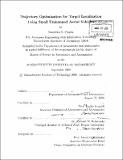Trajectory optimization for target localization using small unmanned aerial vehicles
Author(s)
Ponda, Sameera S
DownloadFull printable version (46.55Mb)
Other Contributors
Massachusetts Institute of Technology. Dept. of Aeronautics and Astronautics.
Advisor
Emilio Frazzoli and Richard M. Kolacinski.
Terms of use
Metadata
Show full item recordAbstract
Small unmanned aerial vehicles (UAVs), equipped with navigation systems and video capability, are currently being deployed for intelligence, reconnaissance and surveillance missions. One particular mission of interest involves computing location estimates for targets detected by onboard sensors. Combining UAV state estimates with information gathered by the imaging sensors leads to bearing measurements of the target that can be used to determine the target's location. This 3-D bearings-only estimation problem is nonlinear and traditional filtering methods produce biased and uncertain estimates, occasionally leading to filter instabilities. Careful selection of the measurement locations greatly enhances filter performance, motivating the development of UAV trajectories that minimize target location estimation error and improve filter convergence. The objective of this work is to develop guidance algorithms that enable the UAV to fly trajectories that increase the amount of information provided by the measurements and improve overall estimation observability, resulting in proper target tracking and an accurate target location estimate. The performance of the target estimation is dependent upon the positions from which measurements are taken relative to the target and to previous measurements. Past research has provided methods to quantify the information content of a set of measurements using the Fisher Information Matrix (FIM). Forming objective functions based on the FIM and using numerical optimization methods produce UAV trajectories that locally maximize the information content for a given number of measurements. In this project, trajectory optimization leads to the development of UAV flight paths that provide the highest amount of information about the target, while considering sensor restrictions, vehicle dynamics and operation constraints. (cont.) The UAV trajectory optimization is performed for stationary targets, dynamic targets and multiple targets, for many different scenarios of vehicle motion constraints. The resulting trajectories show spiral paths taken by the UAV, which focus on increasing the angular separation between measurements and reducing the relative range to the target, thus maximizing the information provided by each measurement and improving the performance of the estimation. The main drawback of information based trajectory design is the dependence of the Fisher Information Matrix on the true target location. This issue is addressed in this project by executing simultaneous target location estimation and UAV trajectory optimization. Two estimation algorithms, the Extended Kalman Filter and the Particle Filter are considered, and the trajectory optimization is performed using the mean value of the target estimation in lieu of the true target location. The estimation and optimization algorithms run in sequence and are updated in real-time. The results show spiral UAV trajectories that increase filter convergence and overall estimation accuracy, illustrating the importance of information-based trajectory design for target localization using small UAVs.
Description
Thesis (S.M.)--Massachusetts Institute of Technology, Dept. of Aeronautics and Astronautics, 2008. Includes bibliographical references (p. 189-197).
Date issued
2008Department
Massachusetts Institute of Technology. Department of Aeronautics and AstronauticsPublisher
Massachusetts Institute of Technology
Keywords
Aeronautics and Astronautics.